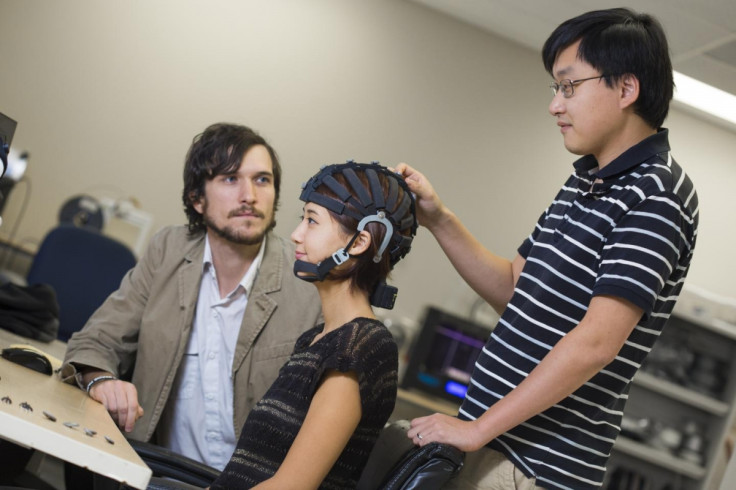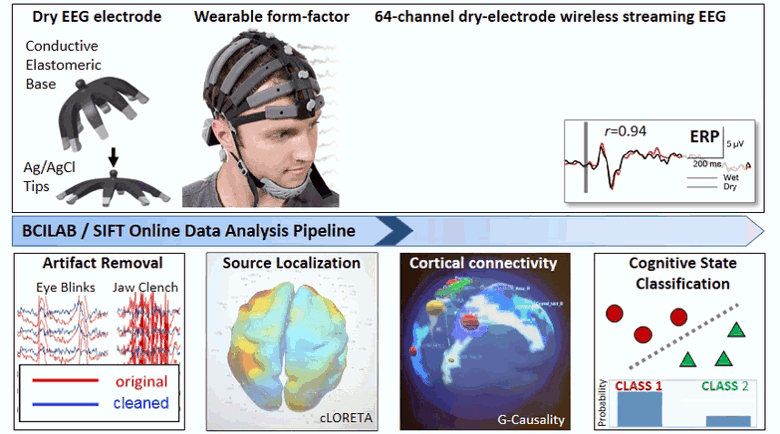First-ever portable brain monitor could lead to breakthrough in human-like computer experience

Bioengineers and cognitive scientists from the University of California San Diego have figured out how to take brain monitoring out of the laboratory, which opens up the potential for a myriad of real-world applications, from improving healthcare to creating brain-computer interfaces so humans can control machines with their minds.
The researchers have developed the world's first portable, 64-channel wearable brain activity monitoring system, which comes with a dry-electrode wearable EEG headset and a software suite to interpret and analyse the data.
EEG is a technology that involves attaching numerous small sensors to the scalp in order to record and pick up electrical P300 signals by looking at patterns of electrical activity in the brain. Traditionally, the technology has been used primarily in the medical field to diagnose and monitor types of seizures for epilepsy treatment and monitor brain function in intensive care patients.
Invasive brain surgery could become a thing of the past

The dry EEG headset is shaped like an octopus with elastic arms to enable it to fit a wide a range of heads, while sensors made located at the end of each arm collect the strongest signal possible from the brain without adding noise to the signal.
The sensors designed to pick up the brain signals from the user's hair are made from a mixture of silver and carbon on a flexible underlying layer to ensure flexibility and good conductivity of the brain signals, while the sensors resting on bare skin are made from a hydrogel encased inside a conductive membrane, and then mounted inside a pod equipped with an amplifier to boost signal quality and shield the sensors from interference of other electronic gadgets nearby.
The data from the headset is then analysed by software that includes algorithms to separate the EEG data in real-time into different components to remove noise, and then the brain signals are tracked and used to build a network map of brain activity. Finally, machine learning is used to connect specific network patterns in the brain activity recorded to specific behaviour and cognition.
Imagine smartphones picking up instructions from your mind

Currently, EEG is limited to laboratories and to wet EEG methods, but the UC San Diego invention could have huge implications in both medicine and technology. In healthcare, it has the potential to help improve how we treat brain injuries.
"We will be able to prompt the brain to fix its own problems," said Gert Cauwenberghs, a bioengineering professor at the Jacobs School and a principal investigator of the research. "We are trying to get away from invasive technologies, such as deep brain stimulation and prescription medications, and instead start up a repair process by using the brain's synaptic plasticity."
The technology could also be used in neuroimaging systems and even to create brain-machine interfaces where people would only need to think instructions and their smartphone, computer or even self-driving car would immediately be able to carry out the command.
"This is going to take neuroimaging to the next level by deploying on a much larger scale," said Mike Yu Chi, a Jacobs School alumnus and CTO of Cognionics who led the team that developed the headset used in the study. "You will be able to work in subjects' homes. You can put this on someone driving."
There's still a way to go before these applications are possible, but the researchers' work highlights important first steps.
"A Holy Grail in our field is to track meaningful changes in distributed brain networks at the 'speed of thought'," said Mullen Kothe, a former researcher at the Swartz Center for Computational Neuroscience and currently CTO of Qusp, which developed NeuroScale, a cloud-based software platform that provides continuous real-time interpretation of brain and body signals through an internet application program interface. "We're closer to that goal, but we're not quite there yet."
The invention and its software is outlined in the paper, "Real-time neuroimaging and cognitive monitoring using wearable dry EEG" published in the journal IEEE Transactions on Biomedical Engineering.
© Copyright IBTimes 2024. All rights reserved.







